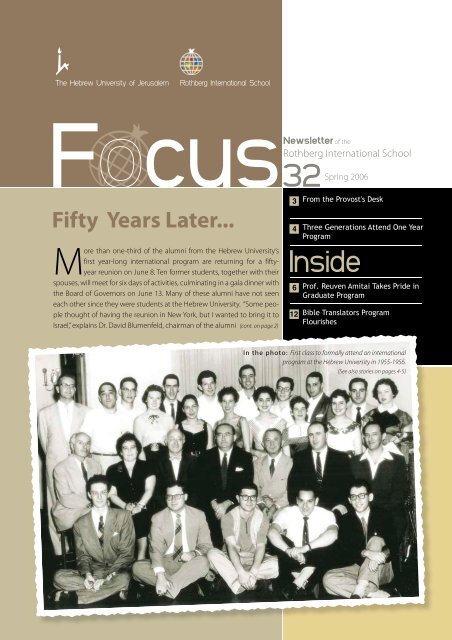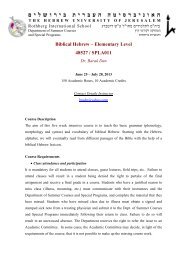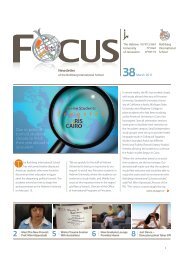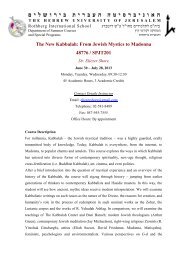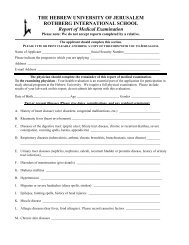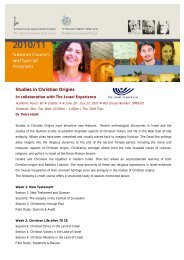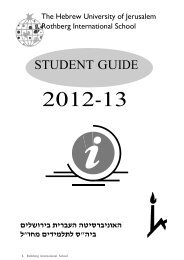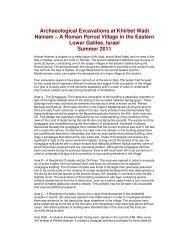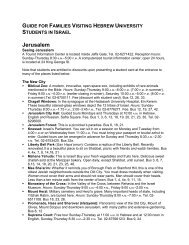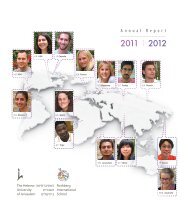You also want an ePaper? Increase the reach of your titles
YUMPU automatically turns print PDFs into web optimized ePapers that Google loves.
The Hebrew University of Jerusalem<br />
<strong>Rothberg</strong> <strong>International</strong> <strong>School</strong><br />
F cus<strong>Rothberg</strong><br />
Fifty Years Later...<br />
More than onepthird of the alumni from the Hebrew University’s<br />
first yearplong international program are returning for a fiftyp<br />
year reunion on June 8. Ten former students, together with their<br />
spouses, will meet for six days of activities, culminating in a gala dinner with<br />
the Board of Governors on June 13. Many of these alumni have not seen<br />
each other since they were students at the Hebrew University. “Some peop<br />
ple thought of having the reunion in New York, but I wanted to bring it to<br />
Israel,” explains Dr. David Blumenfeld, chairman of the alumni (cont. on page 2)<br />
Newsletter of the<br />
32<br />
<strong>International</strong> <strong>School</strong><br />
Spring <strong>2006</strong><br />
3<br />
From the Provost's Desk<br />
4 Three Generations Attend One Year<br />
Program<br />
Inside<br />
6<br />
12<br />
Prof. Reuven Amitai Takes Pride in<br />
Graduate Program<br />
Bible Translators Program<br />
Flourishes<br />
In the photo: First class to formally attend an international<br />
program at the Hebrew University in 1955-1956.<br />
(See also stories on pages 4-5)
2<br />
FOCUS 32 3<br />
In March, Nobel laureate Prof. Robp<br />
ert J. Aumann, of the Hebrew Unip<br />
versity’s Einstein Institute of Mathp<br />
ematics and Center for the Study of<br />
Rationality, came to the RIS to lecture<br />
to students enrolled in a new underp<br />
graduate course in Game Theory. The<br />
course is taught by his former student<br />
and colleague, Dr. EinpYa Gura, who is<br />
also the coordinator of mathematics<br />
at the RIS Mechina. Prof. Aumann told<br />
the class how he became involved in<br />
game theory, including meetings he<br />
had with Prof. John Nash, a 1994 Nop<br />
bel Prize winner and the subject of<br />
the movie A Brilliant Mind.<br />
“It was a privilege for the students to<br />
be in a class with a Nobel Prize winp<br />
ner,” says Yoel Nesson, director of the<br />
Division of Undergraduate Studies.<br />
Fifty Years Later (cont. from page 1)<br />
reunion committee. “In New York, we<br />
would just be some oldptimers shootp<br />
ing the breeze, but in Israel, we can<br />
join in solidarity with the Board of<br />
Governors. We want to raise the profile<br />
of the international program. We were<br />
the pioneers, and now we are returnp<br />
ing fifty years later with hope for a sucp<br />
cessful future.”<br />
Congratulations<br />
The following RIS and Hebrew<br />
University academic staff received<br />
citations from the Rector’s office<br />
for excellence in teaching at the<br />
RIS, according to a student survey:<br />
Dr. Pinhas Bibelnik<br />
Mr. Albert Dwek<br />
Prof. Moshe Idel<br />
Ms. Sara Israeli<br />
Prof. Israel Levine<br />
Ms. Shachar Loshinsky<br />
Ms. Bruria Ettinger-Rehavi<br />
Nobel Games<br />
Prof. Robert J. Aumann lectures to RIS students.<br />
The program for the reunion will alp<br />
low the former students and their<br />
spouses to reacquaint themselves<br />
with Jerusalem and, specifically, bep<br />
come acquainted with the <strong>Rothberg</strong><br />
<strong>International</strong> <strong>School</strong>, which did not<br />
exist in 1955.<br />
On June 8, there will be an RIS dinner<br />
for alumni at the Inbal Hotel with the<br />
RIS provost, vice provost and academp<br />
ic directors. In addition, three distinp<br />
guished former teachers of the group,<br />
Prof. Haim Beinart, Prof. Dov Noy and<br />
Prof. Shemaryahu Talmon, will be<br />
present. On June 12, the group will<br />
tour the RIS and meet with current dep<br />
partment heads, senior lecturers, and<br />
students, visit classrooms and watch<br />
a presentation of new Hebrew multip<br />
media programs. In the afternoon, the<br />
alumni will meet with former teachers<br />
and tour the Boyar Building.<br />
Blumenfeld, along with many other<br />
alumni, credit the year with addp<br />
ing an important dimension to their<br />
lives. “Aside from becoming a rabbi,<br />
I received a Ph.D. in Near Eastern Litp<br />
erature and Language because of my<br />
year at the Hebrew University. It very<br />
much influenced me,” he asserts.<br />
David L. Kline remembers turning 20<br />
in Israel. To him, the year was eventful,<br />
memorable and influential. “Adapting<br />
to a world beyond the protection of<br />
home and college left me more sep<br />
cure and open to fresh possibilities,”<br />
he recalls. “The atmosphere at the Hep<br />
brew University reversed my sophop<br />
more blues and the Bible teachers<br />
there, [Shemaryahu] Talmon, [Menap<br />
hem] Haran, and [Nechama] Leibop<br />
witz, introduced me to what became<br />
a lifelong interest.”<br />
For Frieda (Lustig) RosemanpResnick,<br />
the reunion is practically in her backp<br />
yard. She is one of two members of<br />
her class to make aliyah, and she credp<br />
its her aliyah to the year spent at the<br />
Hebrew University. “I’m coming to the<br />
reunion in order to reacquaint myself<br />
with my former classmates and find<br />
out about their lives in the last 50<br />
years,” she says. “It’s hard to realize that<br />
the year of 1955 really belonged to anp<br />
other world – another century – and<br />
another era – as compared to <strong>2006</strong>.”<br />
From the<br />
Dear Students and Friends,<br />
It is a great pleasure for me to address<br />
you in the current issue of FOCUS.<br />
The past school year, 2005/<strong>2006</strong>, has<br />
been a wonderful and highly rewardp<br />
ing year for all of us at the <strong>Rothberg</strong><br />
<strong>International</strong> <strong>School</strong> – a year of conp<br />
tinuing growth in student enrollment,<br />
accompanied by the introduction of<br />
new courses and development of new<br />
study programs.<br />
The significant increase in student<br />
numbers is a direct reflection of the<br />
marked improvement in personal sep<br />
curity, which influenced the decision<br />
of universities in the U.S. to reinstate<br />
their study abroad programs in Israel,<br />
previously suspended in the wake of<br />
the Intifada.<br />
Newly introduced academic prop<br />
grams include a onepyear Program for<br />
Training Teachers of Hebrew as a Forp<br />
eign Language. This program is conp<br />
ducted by the RIS Division of Hebrew<br />
Language Instruction and the <strong>School</strong><br />
of Education, and provides the gradup<br />
ates with a teaching certificate from<br />
the Hebrew University. Currently, Isp<br />
raeli students are participating in this<br />
program, which will admit overseas<br />
students as well for the <strong>2006</strong>/2007<br />
academic year.<br />
A new M.A. program in Community<br />
Leadership and Philanthropy is awaitp<br />
ing final approval by the University<br />
academic authorities. This innovative<br />
and timely program was developed<br />
in cooperation with the Paul Baerwald<br />
<strong>School</strong> of Social Work and Social Welp<br />
fare, and aims to provide professional<br />
leadership for communities all over<br />
the world, including Jewish commup<br />
nities in the Diaspora.<br />
New science courses have been<br />
introduced into the teaching curricup<br />
lum of the Division of Undergraduate<br />
Studies, aiming to attract science map<br />
jors to the RIS. We are now considering<br />
the introduction of a special Freshman<br />
Program in Science, as well as offering<br />
research lab experience combined<br />
with appropriate course work.<br />
We are continuing our important<br />
contribution to the absorption of<br />
newly arrived immigrants from Rusp<br />
sia, France, Latin America and the U.S.<br />
enrolled in our Mechina year program,<br />
which also hosts immigrant Israeli<br />
army veterans. This is one of the ways<br />
in which we participate in the imporp<br />
tant mission of the Hebrew Univerp<br />
sity to be the University of the Jewish<br />
People.<br />
The Office of Student Activities<br />
(OSA) continues to introduce new<br />
activities and to be staffed by well<br />
trained, dedicated madrichim. We have<br />
also hired a partptime psychological<br />
counselor, who has made significant<br />
contributions to the wellpbeing of our<br />
students and staff.<br />
You will find in the present issue of<br />
FOCUS touching testimonies of our<br />
students on a trip to Poland and their<br />
exposure to the life of Jewish comp<br />
munities annihilated during the Holop<br />
caust, on volunteering in the commup<br />
nity, and on the personal experience in<br />
Israel of students coming from as far<br />
as Mongolia. Additional articles deal<br />
with our teachers and other aspects of<br />
our life at the Boyar Building on Mount<br />
Scopus.<br />
At Newsletter the time you of the read this newsletp<br />
ter,<br />
<strong>Rothberg</strong><br />
we will be<br />
<strong>International</strong><br />
hosting a group<br />
<strong>School</strong><br />
of U.S.<br />
alumni who attended in 1955/1956<br />
the first onepyear program for overseas<br />
students at the Hebrew University,<br />
which set the ground for what would<br />
later become the RIS. These alumni<br />
will meet with some of their teachers<br />
and with current staff and students at<br />
the RIS. We salute warmly the “Class<br />
of 55/56” and wish them continued<br />
good health and happiness. Likewise, I<br />
would like to salute all our alumni since<br />
1955/1956 and invite them to join us<br />
in strengthening their alma mater, the<br />
<strong>Rothberg</strong> <strong>International</strong> <strong>School</strong>.<br />
I would also like to thank all the teachp<br />
ers and staff of the RIS for their remarkp<br />
able professional work and dedication<br />
to our <strong>School</strong>, and look forward to a<br />
rewarding and enjoyable school year<br />
in <strong>2006</strong>/2007.<br />
Prof. Jaime Kapitulnik<br />
June <strong>2006</strong>
4<br />
FOCUS 32 5<br />
Mark Meskin and Ilana Perlman (Meskin) during<br />
their year at the Hebrew University.<br />
From North America to Hebrew University:<br />
Three Generations Att end One Year Program<br />
The Meskins: (left to right) Myra, Ilana, Mark, Diane<br />
Fifty years ago, a group of North American students traveled to Israel<br />
for fourteen days on a ship in order to study at the Hebrew University’s<br />
nascent international program. One member of the group, Melvin Perlp<br />
man, who was a student at Yale University, had never been to Israel and felt<br />
that he was at a crossroads in his life: Should he go to rabbinical school or<br />
pursue other academic channels? The year in Israel would end up having a<br />
profound impact on his life in more than one way, although it was not an<br />
easy year. “My father was literally hungry all year,” his daughter Ilana Meskin,<br />
OYP 1976p77, recalls him saying, “He was so poor that he did not have enough<br />
money to buy food!”<br />
On the other hand, studying at the Hebrew University sparked an interest in<br />
archeology, which in turn led to his pursuing a doctorate at Oxford University<br />
in anthropology. Aside from giving him professional direction, the year ended<br />
with his marriage. “He became friendly with a woman named Tina Waxsman,”<br />
says Ilana. “When he decided to go to France at the end of the year, she gave<br />
him two names of women who spoke some English to show him around, and<br />
one was the name of the family of his future wife.” Pat Penn, an alumna from<br />
that year, remembers that by the time the group returned by ship, Perlman<br />
had a new bride, Eva.<br />
This year, the original group of students is having a 50th anniversarypyear rep<br />
union in Jerusalem [See front page]. Many of them are bringing their children<br />
and grandchildren on the trip. Unfortunately, though, Mel Perlman will not be<br />
one of them. He died of leukemia 18 years ago, but his legacy as a student at<br />
the Hebrew University remained in the family. First, his daughter, Ilana Perlp<br />
man Meskin, came in 1976, and this year, his granddaughter, Diane, is studyp<br />
ing at the RIS (see article below).<br />
Diane Meskin, 20, is a student at<br />
the University of California at<br />
San Diego, majoring in political scip<br />
ence with an emphasis on internap<br />
tional relations and a minor in Midp<br />
dle East relations. For Diane, coming<br />
to Israel was a natural move. First<br />
and foremost, her family fostered<br />
her love for Israel. She is the third<br />
generation from her family to come<br />
and study here. “It is special to feel a<br />
sort of legacy,” she says with a smile.<br />
“It is amazing that, 50 years after my<br />
grandfather studied here, the <strong>School</strong><br />
is still strong and flourishing.”<br />
“My parents were my ardent supporters when I decided to come to study at<br />
the Hebrew University,” recalls Ilana. “When I came, there was a good internap<br />
tional contingent at the <strong>School</strong>. We lived on Mount Scopus already, although<br />
the Ulpan was in Givat Ram.” Following in her father’s footsteps, she came<br />
home with her future husband. “I met Mark in Pesach Schindler’s Talmud class.<br />
We both went to the Chanukah party at his house, although we only started<br />
dating officially at Purim time,” she says.<br />
After getting her bachelor’s degree in Linguistics from York University in Canp<br />
ada, she married Mark and they moved to Los Angeles, where she currently<br />
works as a director of human resources at Amgen. The year in Israel also gave<br />
her husband Mark his professional orientation, albeit in a unique way. He bep<br />
came interested in Jewish dietary laws, which led him to pursue a doctoral<br />
degree in Nutrition. Today, he is the director of the Clinical Nutrition program<br />
at California State Polytechnic University, Pomona. Mark fondly recalls that<br />
the year was full of tiyulim around the country, including trips to places like<br />
Hebron and Sinai, no longer destinations for students today.<br />
Twentypnine years after their year at the Hebrew University, Mark and Ilana,<br />
together with their younger daughter Myra, came to visit their daughter Dip<br />
ane at the RIS. “One of the highlights of my visit this year was walking into the<br />
conference room at the RIS and seeing a photo of the class of 1955 with each<br />
person’s name handwritten below the picture. When I saw my father’s face, I<br />
burst into tears,” she says. Meskin then promised RIS Provost Jaime Kapitulnik,<br />
that her daughter would return from the Passover vacation with a huge, high<br />
quality photo of the original class [featured on the front page]. “This is our way<br />
of participating in the reunion and honoring my father’s memory,” she says.<br />
“The Perlman/Meskin family cherishes their experiences and memories of life<br />
on Mount Scopus – today, as well as 29 and 50 years ago.”<br />
Second, she had spent three months<br />
living with a family in Tel Aviv and<br />
studying in high school as part of<br />
an exchange program at the Milken<br />
Community High <strong>School</strong> in Los Anp<br />
geles, so she knew she wanted to<br />
come back. She is also involved in<br />
Israel advocacy on her college camp<br />
pus. At the end of her freshman year,<br />
she became heavily involved in the<br />
San Diego Israel Alliance. She fought<br />
to get the Israel program at the Unip<br />
versity of California reinstated, but to<br />
no avail. [UC cancelled their recognip<br />
tion and representative to the RIS in<br />
2001.]<br />
Diane was sone of the first students<br />
to be accepted into the new Middle<br />
East Honors Program at the RIS. [See<br />
box.] “This is a really strong program<br />
and it is a good thing to offer stup<br />
dents who have background,” she<br />
comments. In addition to her studp<br />
ies, Meskin is also interning at the<br />
Jerusalem Post, writing about cultural<br />
events in the Billboard Section of the<br />
newspaper. “It is an interesting expep<br />
rience,” she says. “I’ve always thought<br />
of writing in some way, so any expep<br />
rience is good.”<br />
Dr. Melvin Perlman:<br />
Ilana's father,<br />
Diane's grandfather<br />
Middle East Honors<br />
Program<br />
Newsletter of the<br />
<strong>Rothberg</strong> <strong>International</strong> <strong>School</strong><br />
he RIS One Year Program instituted an<br />
T honors program this year in Middle East<br />
Studies. The program is open to a limited<br />
number of students who have advanced<br />
standing or are majors in Middle East studp<br />
ies, international relations or political scip<br />
ence. Application is competitive and an adp<br />
visory committee selects participants.<br />
“The program was instituted to offer more<br />
challenging courses to outstanding stup<br />
dents with related backgrounds coming<br />
to study at the RIS,” explains Yoel Nesson,<br />
administrative director of the Division of<br />
Undergraduate Studies. In addition to adp<br />
vanced seminars and a reading group, the<br />
participants go on special field trips and are<br />
privy to selected guest lectures. Twentyp<br />
seven students were accepted into the prop<br />
gram for spring semester. “This was our first<br />
year of operation and it was extremely sucp<br />
cessful,” says Nesson. “Next year, the <strong>School</strong><br />
plans to open a similar honors program in<br />
Israel Studies, as well.”
6<br />
FOCUS 32 7<br />
Prof. Amitai Takes Pride in Graduate Program<br />
Prof. Reuven Amitai<br />
Portrait<br />
of an M.A.<br />
Student<br />
When Professor Reuven Amitai made aliyah from Philadelphia in 1976,<br />
his plans were to live and work on a kibbutz, and in his spare time<br />
topursue his interest in Middle Eastern Studies. He spent six years on<br />
Kibbutz Harel working as a welder, but life in a small collective village proved to<br />
be too quiet for him.<br />
“Did I want to be a kibbutznik with a hobby or a scholar with kibbutz memories?” he<br />
asked himself before enrolling in the Hebrew University to pursue a Master's degree<br />
in Middle Eastern Studies. Prof. Amitai was impressed with the level of Arabic studip<br />
ies at the University and, in general, with the academic level. Although he had been<br />
engrossed by the modern Middle East while studying for his B.A. at the University<br />
of Pennsylvania, his interests changed when he came to Jerusalem. He decided to<br />
focus on a much earlier period in the history of Islam, namely: the time of the Crusp<br />
sades, the Mamluks and the Mongols (roughly 1,000 c.e.through 1,500 c.e.).<br />
After finishing his Ph.D. at the Hebrew University in 1990, and spending a year at<br />
Princeton University doing post-doc research, he came back to teach at the Hebrew<br />
University, and soon after at the new RIS graduate program in Islamic and Middle<br />
Eastern Studies.<br />
As he took on increasingly senior administrative positions at the Hebrew University,<br />
first as chairman of the Department of Islamic and Middle Eastern Studies (from<br />
1997) and then as director of the Institute of Asian and African Studies (2001-03),<br />
Prof. Amitai also became more interested and more involved in the Division of<br />
Graduate Studies at the RIS. “One of the first things I did was to help get appointed<br />
an advisor from the Department – Dr. Roni Shaham – to act as a coordinator in the<br />
graduate program. I wanted to have a contact person who would know what was<br />
going on with the classes and with the students but also knew what the Departmp<br />
ment was about,” explains Prof. Amitai. “Because I had been teaching in the program<br />
and was from abroad, I had an interest in seeing the program develop.” Prof. Amitai,<br />
together with colleagues, also engaged in a creative marketing strategy to attract<br />
more international students. Instead of working through campus Hillel offices or<br />
the Friends of the Hebrew University, they directed their recruitment efforts to the<br />
Middle Eastern Studies departments at different universities abroad.<br />
To his satisfaction, Prof. Amitai feels that the RIS program has gradually developed<br />
from the inside with a stronger caliber of students attending and a higher level and<br />
Maya Kroitoru, 24, had wanted to study in Israel since her undergraduate<br />
years at the University of Colorado at Boulder, where she majored in internp<br />
national affairs and economics. When she received a scholarship through<br />
the National Security for Education Program, intended for study abroad in world<br />
areas critical to U.S. National Security, she thought that she had literally found her<br />
ticket. Unfortunately, the program would not allow her to study in Israel because of<br />
security restrictions at the time. Instead she went to Prague, where she enrolled in a<br />
Jewish Studies program, and from there she traveled to Morocco, where she enrolled<br />
in an Arab Studies program. “When I was in Morocco, I became convinced that my<br />
next step was to come to Israel,” she says. In addition to her academic interest in the<br />
country, Kroitoru has a personal interest: Her father is Israeli.<br />
After graduating college, she applied for and was granted an Anna Sobol Levy Fellp<br />
lowship to study the RIS Division of Graduate Studies. Kroitoru began her studies last<br />
wider variety of classes being taught. “The internal dynamic in the program has<br />
improved. We are attracting students with a proper background in Middle Eastern<br />
Studies,” he maintains. “This year we have 40 applicants. I understand that it is the<br />
most popular program in the Division.” In addition to the quality of the teachers,<br />
Prof. Amitai is certain that the location is a draw for students. “Jerusalem has a very<br />
good reputation for providing a world class university (certainly in Middle Eastern<br />
Studies) that physically neighbors the Arab world. As students take classes in the<br />
Middle East, they can hear the muezzin calling Muslims to prayer. The program has<br />
definitely become a flagship for the <strong>School</strong>,” he says.<br />
Prof. Amitai enjoys teaching at the RIS. “The students are interested in scholarship.<br />
They generally do the reading – and in my class,” he admits, “there is a lot of reading!<br />
It is a lively crowd and discussions are on a high level.” Prof. Amitai promotes the<br />
involvement of RIS students in his Department’s activities, encouraging those with<br />
a good command of Hebrew to attend lectures or seminars. He would like to see<br />
more graduates of the <strong>School</strong>’s M.A. program continuing to pursue a doctorate at<br />
the Hebrew University.<br />
Recently, Prof. Amitai was appointed director of the Nehemia Levtzion Center for<br />
Islamic Studies, which opened less than two years ago. The goal of the Center is to<br />
encourage research and public activity, related to Islamic studies. “We have great<br />
departments at the University [e.g. Islamic and Middle Eastern Studies and Arabic<br />
Language and Literature], but this is going beyond teaching,” he says.<br />
Activities have included a one- day conference with Yad Ben Zvi on the formation<br />
of Islamic society in the Land of Israel, a conference in conjunction with Mishkenot<br />
Sha’ananim on contemporary Islam, an ongoing discussion group about religious<br />
experience in its social context, and a new lecture series in conjunction with the<br />
Forum for European Studies on Islam in Europe.<br />
“In general, we try not to be either polemical or apologetic at the Center,” explains<br />
Prof. Amitai. “I believe there needs to be dialogue between scholars studying the<br />
pre-modern and modern Middle East and Islam. The modernists sometimes have a<br />
certain lack of regard for scholarship on the 'medieval' period and vice versa, but it is<br />
only while working together that we can present a complete picture of the Muslim<br />
world to the public. Our Center is trying to bridge that gap.”<br />
year, but after four months she realized one year would not be enough to accomp<br />
plish her goal of becoming proficient in both Hebrew and Arabic. She requested to<br />
extend her fellowship for a second year in order to finish her M.A. degree in Islamic<br />
and Middle Eastern Studies. She then plans to return to the U.S. to pursue a career in<br />
international relations, ideally in some sort of analyst position at a research institute in<br />
Washington, D.C. “I decided on this career after reading Thomas Friedman’s The Lexus<br />
and the Olive Tree,” she says. “I am mostly interested in American-Israeli relations and<br />
ethnic conflict .” Given her professional interests, she was very pleased to be one of<br />
the RIS students chosen to meet with U.S. Ambassador to Israel Richard H. Jones (see<br />
page 16). “We held a fairly serious discussion about cross-cultural experiences,” she<br />
says. “He talked to us about his diplomatic career, and he inspired us to get further<br />
involved in policy making and in learning languages.” Thanks to her studies in Israel,<br />
she has mastered the Hebrew language.<br />
”This year we have<br />
40 applicants.<br />
I understand that<br />
Middle Eastern<br />
Studies is the most<br />
Newsletter of the<br />
<strong>Rothberg</strong> <strong>International</strong> <strong>School</strong><br />
popular program in<br />
the Division.”<br />
Maya Kroitoru
8<br />
FOCUS 32 9<br />
5<br />
French Mechina students dressed up as Indians as part<br />
of the Purim festivities: at the RIS this year (from left)<br />
Bismuth Lary from Nice and Chloë Haïk from Paris.<br />
1<br />
2<br />
3<br />
4<br />
Students take a break during the annual SeaptopSea trip, which took place in late April.<br />
For four days, the hikers walked from the Mediterranean Sea to the Sea of Galilee.<br />
Marina Brener from Buenos Aires, Argentina, stands next to Yoshiko Takeda from<br />
Japan, after both participated in a Mechina hatpmaking workshop in honor of Purim.<br />
Twentyptwo doctors, nurses, researchers and senior officials from various countries, inp<br />
cluding a delegation from Sri Lanka, which was hit by the tsunami, participated in a<br />
twopweek seminar last summer called “Medicine and Society: Emergency Preparedness<br />
and Response.” The course combined lectures, practical exercises and field visits.<br />
1<br />
2<br />
RIS students enjoyed a navigap<br />
tion race in the Ben Shemen<br />
forest outside of Jerusalem last<br />
November. The race was part of<br />
a series of activities sponsored<br />
by OSA. Students were given<br />
maps and compasses and had<br />
to navigate their way to a desp<br />
ignated finishing point.<br />
5<br />
6<br />
Swing of Purim<br />
Newsletter of the<br />
<strong>Rothberg</strong> <strong>International</strong> <strong>School</strong><br />
3<br />
4<br />
6<br />
Mechina students get into the swing of Purim at a party<br />
held in the courtyard of the Boyar Building.
10<br />
FOCUS 32 11<br />
Internships for credit are popular at<br />
the RIS. They allow students to get<br />
to know the country from the inside,<br />
to im prove their Hebrew and, often, to<br />
combine an academic or professional<br />
interest with “hands-on” experience.<br />
Miriam Schwartz, 21, from St. Louis,<br />
Missouri, wanted to foster a growing<br />
interest in Ethiopian Jewry. Schwartz,<br />
a student at the New College of<br />
Florida, is attending the RIS One Year<br />
Program, where she also participates<br />
in the Lainer Interns for Jewish Educp<br />
cation Program sponsored by JESNA.<br />
“My Jewish identity is very important<br />
to me and I want to consider living in<br />
Israel,” says Schwartz. In addition, she<br />
is seriously considering pursuing Jewip<br />
ish education in graduate school. Back<br />
Interns Gain<br />
Hands-On<br />
Experience<br />
Jonah Gordon with lemurs at the Jerusalem Biblical Zoo.<br />
home, she is the president of the camp<br />
pus Hillel, she taught Hebrew <strong>School</strong>,<br />
and was a USY youth advisor.<br />
As a Lainer Intern, she needed to find<br />
an internship related to Jewish educp<br />
cation. She knew from the start that<br />
she wanted to work with Ethiopian<br />
children. For one, she had presented a<br />
huge project on Ethiopian Jewry for a<br />
class on Race and Ethnicity at New Collp<br />
lege. In addition, she had volunteered<br />
at an Ethiopian Immersion center, with<br />
kindergartners. As requested, she was<br />
assigned to tutor English to four sixth<br />
grade Ethiopian girls in the Neve Yaakp<br />
kov neighborhood in Jerusalem.<br />
She meets with her pupils three hours<br />
a week. She teaches them English and<br />
they teach her about being Ethiopian<br />
in Israel. “The girls are energetic and<br />
smart and quick to pick up things.<br />
The challenge is to discipline them,”<br />
she says. One of her most creative and<br />
successful ideas was bringing music to<br />
the tutoring session and helping the<br />
girls translate the hip-hop songs into<br />
Hebrew. “I try to show them how relep<br />
evant English is,” she explains.<br />
“I am always telling them how smart<br />
they are, giving them treats when<br />
they’re good and raising their confidp<br />
dence.” Schwartz believes “they have<br />
taught me the challenges of the immigp<br />
grant experience, but also the positive<br />
energy that Ethiopians have brought<br />
to Israel.”<br />
Jonah Gordon, 26, a psychology<br />
major at York University, in Toronto, is<br />
spending spring semester at the RIS.<br />
Hoping to find a way to express his intp<br />
terest in animals, he asked Keri Rosenbp<br />
bluh, the RIS internship coordinator, if<br />
there was an internship at a local zoo.<br />
She immediately pointed him towards<br />
Jerusalem’s Biblical Zoo.<br />
Gordon was thrilled. He had spent the<br />
past two summers working for Canadp<br />
dian Young Judaea, taking campers<br />
on canoe trips in Killarney Park, where<br />
he was surrounded by such wildlife as<br />
moose, bears and beaver. He became<br />
interested in African-based animals, esp<br />
pecially primates, after taking a course<br />
in Animal Behavior.<br />
“It is incredible to see the physical and<br />
emotional similarities between chimp<br />
panzees, lemurs and humans,” says Gordp<br />
don. When I look into their eyes I feel as<br />
if there is a mutual understanding. As I<br />
watch the way they move and interact<br />
with each other, I can see where we<br />
come from.”<br />
The zoo assigned him to work with the<br />
chimpanzees, lemurs, mandrills and<br />
squirrel monkeys. Once a week, Gordon<br />
joins other volunteers for several hours<br />
of cleaning out cages and giving out<br />
the animals’ food. Every morning physicp<br />
cal examinations are done to check the<br />
limbs and torsos of all the monkeys.<br />
The animals have been trained to line<br />
up alongside the bars and hold out<br />
their arms, legs, fingers and toes upon<br />
request. “The staff hardly ever go into<br />
the animals’ cages, rather they work<br />
with them through the bars,” he exp<br />
plains. “The whole idea behind caring<br />
for these animals is to know that they<br />
are not human and do not want to be<br />
treated as humans. Their thought procp<br />
cesses are very different from ours.”<br />
What most impresses Gordon is the<br />
tremendous number of volunteers<br />
that work together at the zoo. “There<br />
are foreigners and Arabs and Israelis<br />
all working together to keep the zoo<br />
clean and the animals comfortable,”<br />
he says. He hopes to work or volunteer<br />
at the Metro Toronto Zoo when he retp<br />
turns home.<br />
Poland Trip Overwhelms Students<br />
For the first time in four years, 16<br />
undergraduate students from<br />
the RIS traveled to Poland durip<br />
ing the winter intersession on a seminp<br />
nar called “The Jews of Poland from<br />
Kehilla Origins to the Holocaust.” The<br />
smaller attendance rate at the <strong>School</strong>’s<br />
One Year Program in the last few years<br />
had led to the seminar’s cancellation.<br />
However, as a sign of renewed growth<br />
at the RIS, the trip was reinstated this<br />
year. The students could elect to take<br />
the seminar, which was led by Dr. Davp<br />
vid Silberklang, for academic credit by<br />
completing a paper.<br />
Many of the participants felt that journp<br />
neying to Poland was a means of connp<br />
necting with grandparents who had<br />
survived the Holocaust or escaped<br />
Europe before World War Two, leavip<br />
ing family behind. Sari Disenhouse,<br />
21, from Toronto, who is a student at<br />
Dalhousie University in Halifax, Nova<br />
Scotia, has maternal grandparents<br />
who arrived in Canada right before<br />
the outbreak of the war. “They both<br />
lost family there,” she says. “I felt that<br />
this was so important to see in person.<br />
It was very powerful going in the middp<br />
dle of the winter. Walking along the<br />
train tracks and throughout the camp<br />
in ankle deep snow really made me<br />
wonder in awe how people survived<br />
this in the conditions they were in. In<br />
addition to the camps and the gas<br />
chambers, we saw the remains of<br />
communal life in the shtetls and synagp<br />
gogues. We were not remembering<br />
only their deaths but also the lives<br />
they led,” she explains.<br />
One of the most intense moments for<br />
Disenhouse was standing near the gas<br />
chambers in Birkenau and responding<br />
to the mourner’s prayer of Kaddish. “So<br />
many did not have the Kaddish said<br />
for them,” she says with a sigh.<br />
Sara Cuneo, 21, from Hamilton, Ontp<br />
tario, a student at McMaster Universp<br />
Students march to Auschwitz-Birkenau.<br />
Newsletter of the<br />
<strong>Rothberg</strong> sity, where <strong>International</strong> she is majoring <strong>School</strong> in politicp<br />
cal science and religious studies, has<br />
grandparents who survived the Holocp<br />
caust. She is the first family member<br />
to make a trip to Poland. “My Bubie’s<br />
family died in Auschwitz. She herself<br />
survived the camp. I went for my Bubp<br />
bie and Zadie,” she says.<br />
For Sara Cuneo this was a very emotp<br />
tional trip. “So much information was<br />
thrown at us but I took little in,” she<br />
admits. “It was the imagery that captp<br />
tured it for me. I felt very close with<br />
my Bubie on the trip and I had such<br />
respect for her because she made it<br />
through.”<br />
The students also met with Rabbi<br />
Michael Shudrich, the chief rabbi of<br />
Warsaw, and with some of the membp<br />
bers of the small Jewish community<br />
remaining in Poland. “A lot of time we<br />
focus on the Holocaust and forget<br />
there are people who are still trying to<br />
be Jews in this country,” says Cuneo.
12<br />
FOCUS 32 13<br />
Bible Translators Program Flourishes<br />
in the Land of the Bible<br />
Nestled in the mountains of the<br />
Jerusalem suburb Mevasseret<br />
Zion is the Home for Bible<br />
Translators (HBT). Established in 1995,<br />
the Home runs a program together<br />
with the RIS for bible translators who<br />
come from abroad to study Modern<br />
and Biblical Hebrew, translating and<br />
text analyses.<br />
Miriam Ronning, a Bible translator<br />
from Finland who has been living in<br />
Israel for the last 25 years, organized<br />
the program out of her love for the<br />
Bible and for Israel. “I personally exp<br />
perienced the difference between<br />
translating with and without a Hebp<br />
braic background,” explains Ronning.<br />
“We talked to linguistic societies who<br />
acknowledged the lack of Hebrew<br />
amongst their translators. Our studp<br />
dents are all professional translators<br />
before they come here. They all come<br />
out of their love for the Bible.”<br />
Most of the students who come are<br />
citizens of African and West African<br />
countries, such as Cameroon, Toga,<br />
Benin, Chad and Nigeria. However,<br />
there is an increasing presence from<br />
Zumbeck Molonz<br />
Asian countries. This year, the Home<br />
has students for the first time from<br />
Papua New Guinea and Mongolia.<br />
Zumbeck Molonz, from Papua New<br />
Guinea, has been peripherally invp<br />
volved in Bible translation since 1972,<br />
when he worked as a consultant<br />
for a linguistic organization to help<br />
its members learn his language. He<br />
worked in the pastoral ministry for<br />
the Lutheran Church before coming<br />
to work as a Bible translator. Although<br />
Papua New Guinea is a small country,<br />
about the size of the state of Californp<br />
nia, its population speaks a total of<br />
855 indigenous languages. Thus, the<br />
need for a national team supervised<br />
by the Bible Translation Association<br />
that will work together to translate<br />
the Old and New Testaments into all<br />
of those languages.<br />
Molonz came to Israel together with<br />
a colleague from the team, Victor<br />
Opung. “Our main interest is that we<br />
want to learn the language and not<br />
have others come and teach it to<br />
us,” he says. “This is a wonderful start.<br />
Knowing Biblical Hebrew enriches<br />
knowledge and understanding of the<br />
text.”<br />
Although most students at the Home<br />
for Bible Translators leave their families<br />
back home when they come to study<br />
for a semester at the RIS, Bayaraa Gar<br />
ram came to study together with his<br />
wife Yanjaa, who was also accepted<br />
to the HBT program. In addition, the<br />
couple has two children, Michael, 4,<br />
and Grace, 2. Instead of living at the<br />
Home in Mevasseret, the couple lives<br />
about 10 minutes away in a small<br />
rented apartment. Bayaraa and Yanjaa<br />
are the first students from Mongolia to<br />
study at the RIS. Bayaraa is also the first<br />
student to receive a scholarship for his<br />
tuition from the Foreign Ministry becp<br />
cause of his outstanding academic<br />
performance.<br />
Bayaraa is currently a graduate studp<br />
dent at the Gordon-Conwell Theolp<br />
logical Seminary outside of Boston,<br />
although his Bachelor’s degree, from<br />
a university in Mongolia, was in Bankip<br />
ing and Finance. Both Bayaraa and<br />
Yanjaa grew up in Ulaanbaatar, the<br />
capital of Mongolia. Bayaraa worked<br />
Bayaraa and Yanjaa Garam with children Michael and Grace.<br />
as a finance manager for six years<br />
and was simultaneously involved<br />
with the Christian Ministry. All along,<br />
he was extremely interested in how<br />
the Bible [Old and New Testaments]<br />
came to be translated into Mongolp<br />
lian and wanted to try to access the<br />
original texts. However, he knew neitp<br />
ther Hebrew nor Greek and was thus<br />
limited to English translations. Before<br />
commencing his graduate studies,<br />
Bayaraa worked as a project manager,<br />
overseeing the translation of a Bible<br />
dictionary into Mongolian. The projep<br />
ect took two years and the end result<br />
was 900 pages. He also worked as a<br />
translator in different fields, including<br />
economics and finance, as well as<br />
Bible related material. Only after accp<br />
cruing a significant amount of translp<br />
lating experience did he embark on<br />
graduate studies in the United States.<br />
“My vision is to translate both Bibles<br />
into Mongolian from their original<br />
languages,” he says. “There is a need<br />
to reflect the original Bible as closely<br />
as possible.”<br />
Yanjaa studied in a teacher training<br />
college to become an elementary<br />
school teacher and she also received<br />
her B.A. in Business Administration.<br />
However, she too left her original<br />
field of study and began working as a<br />
Mongolian language tutor and Englp<br />
lish language translator for five years<br />
for Christian missions in Mongolia.<br />
She then worked as a project manap<br />
ager for World Vision, a humanitarian<br />
Christian organization, which helps<br />
to improve the condition of children<br />
in developing countries. While her<br />
(cont. on page 16)<br />
Nativ directors, past and present, pose at the 25th anniversary gala dinner. From left to right:<br />
RIS Vice Provost Shimon Lipsky Nativ 1-8<br />
David Keren Nativ 9-24<br />
Yossi Garr Nativ 25<br />
Newsletter of the<br />
T he Nativ College Leadership Program <strong>Rothberg</strong> in Israel, <strong>International</strong> a joint venture <strong>School</strong> of the<br />
Hebrew University and the United Synagogue of Conservative Judaip<br />
ism, celebrated its 25th anniversary at a gala happening in the Shalp<br />
lom Jerusalem Hotel in early January. Over 230 people were in attendance,<br />
including alumni and current students.<br />
RIS Vice Provost Shimon Lipsky was the first director of the Nativ program<br />
and has been involved in all aspects of the program. He helped to create<br />
the program and served as its director for eight years. When he first came<br />
to work at the RIS, he supervised Nativ’s academic program. “The success<br />
of the program has been overwhelming,” asserts Lipsky. “It has served as a<br />
model for programs of a similar nature that combine leadership training and<br />
academic studies.”<br />
Nativ’s popularity has been growing in recent years. This year, a record numbp<br />
ber of 64 students studied at the RIS, and David Keren, the director of USY<br />
programs in Israel, expects that number to increase next year. “I think there<br />
has been a change in the mindset in the USY movement. People are beginnp<br />
ning to understand that spending a year in Israel before college is a valuable<br />
option,” Keren explains. “Of course, as the program becomes more popular,<br />
word of mouth helps, and so does the quality of the program.”<br />
Nativ students spend an exclusive mini-semester and autumn semester at<br />
the RIS. They live at Beit Nativ, in Jerusalem's center, and participate in culturap<br />
al and social activities within the Nativ Institute. During the spring semester,<br />
participants choose between living on a kibbutz and community service.
14<br />
FOCUS 32 15<br />
In Memoriam<br />
In recent months we were saddened by the<br />
news of the passing of two remarkable womep<br />
en who made significant contributions to the<br />
<strong>Rothberg</strong> <strong>International</strong> <strong>School</strong>:<br />
Lillian Silbert z"l and<br />
Andrea Bronfman z"l.<br />
Lillian Silbert was the wife and partner of<br />
the late Harvey Silbert, who served on the RIS<br />
Board of Overseers for many years. Among<br />
the various buildings and programs that they<br />
worked to establish at the Hebrew University<br />
is the Lillian and Harvey L. Silbert Family Wing<br />
in the Boyar Building, which houses the Rothbp<br />
berg <strong>International</strong> <strong>School</strong>.<br />
Andrea Bronfman and her husband Charles<br />
R. Bronfman had studied Hebrew at the RIS<br />
Jerusalem Ulpan and were inspired, following<br />
their summer of study, to initiate and fund an<br />
innovative and interactive umbrella program<br />
called Sfatarbut (“Language and Culture”). The<br />
goal of Sfatarbut was, among other things, to<br />
integrate RIS students directly into Israeli sociep<br />
ety with the help of Israeli “friends”. In addition<br />
to the social component, Sfatarbut funded<br />
the expansion of Hebrew language learning<br />
tools, including textbooks, and multimedia<br />
programs. “Andrea wanted students at the RIS<br />
to integrate into Israeli society and not remain<br />
outsiders. The social element was very importp<br />
tant to her,” says Varda Yishai, coordinator of<br />
Sfatarbut.<br />
After completing special six-month MASA Mechina at RIS:<br />
Latin American Students Pursue Degrees at HU<br />
Last year’s MASA students from South America are this year’s Hebrew Universp<br />
sity students. Several of the South American students who attended an accp<br />
celerated six-month Preparatory-Program (Mechina) at the RIS as part of the<br />
Government of Israel’s initiative to bring thousands of Jewish youth from around the<br />
world to study in Israel for at least six months, have remained in Israel. One of the<br />
goals of the MASA program vis-a-vis South America was to encourage outstanding<br />
high school students to come study at the Mechina and facilitate their acceptance<br />
into the Hebrew University. Both Tamara Kohn and Jessica Sidovsky came to the RIS<br />
right after finishing high school in Argentina.<br />
Tamara Kohn, 19, is studying English and Art History at the Hebrew University. “I<br />
decided on my own that I wanted to move to Israel but I did not want to move to an<br />
absorption center. Luba [Glikin – administrative director of the Mechina Program]<br />
offered me the possibility of studying for one semester in the Mechina and living in<br />
the dormitories. It helped me tremendously with my absorption into the country,"<br />
says Kohn.<br />
Jessica Sidovsky, 19, loved the time she spent at the Mechina. “It gave me an opp<br />
portunity to meet others from all over the world,” she says. “I also really enjoyed my<br />
studies.” Today she is studying at the University-Hadassah <strong>School</strong> of Dental Medicp<br />
cine. Although the studies are difficult because of the language, “others are helping<br />
me and it is all good,” she says enthusiastically.<br />
Cynthia Najmarovich, 25, from Argentina, believes that, thanks to her studies at<br />
the Mechina, she achieved high scores on her psychometric exam. “The best thing<br />
was to enter the Hebrew University after having time to acclimate to the environmp<br />
ment,” says Najmarovich. She is studying occupational therapy. “I always wanted to<br />
live in Israel, although I did not really know why, “she says. “Now I know that I want<br />
to live my whole life here.”<br />
Dana Rajchman, 21, from Uruguay, also participated in the six-month accelerated<br />
Mechina program. “I was told that studying at the Mechina would be good for my<br />
absorption and that it would be easier to be accepted into the Hebrew University,”<br />
she says. “My Hebrew and English improved while I was there, and I was accepted<br />
as a second-year biology student thanks to courses I took in Uruguay. It is harder this<br />
way but, in general, it is good.”<br />
New Appointments<br />
Prof. Lawrence Besserman of<br />
the Hebrew University Department<br />
of English has been appointed<br />
Academic Director of the Division of<br />
Graduate Studies. Prof. Besserman<br />
served as Director of the <strong>School</strong>’s<br />
Office of Academic Affairs in the U.S.<br />
in 1988-91.<br />
Amitai Barkol has replaced Gila<br />
Preisler as As sistant Director of<br />
the Division of Hebrew Language<br />
Instruction. Preisler is continuing to<br />
teach Hebrew at the RIS.<br />
Judith Azerrad has assumed the<br />
new position of psychological counsp<br />
selor at the RIS.<br />
Adrian Kramer has been app<br />
pointed administrative director of<br />
the Division of He brew Language<br />
Instruction, replacing Yochi Moshe,<br />
who is now serving as the Assistant<br />
Academic Secre tary of the Hebrew<br />
University.<br />
Motty Butbul has replaced Adrian<br />
Kramer as Director of the Office of<br />
Student Activities (OSA).<br />
Keri Rosenblu has been app<br />
pointed Freshman Program Advisor,<br />
replacing Ronny Perlman, who<br />
retired.<br />
Sara Wilner has been appointed<br />
Student Advisor for RIS Mechina<br />
students from English-speaking<br />
countries. Wilner is an alumna of<br />
the RIS, who received an M.A. in<br />
Society and Politics in Israel in 2004.<br />
Fatin Fahdan is serving as the<br />
Student Advisor for Arab students<br />
from East Jerusalem in the RIS<br />
Mechina. She is pursuing a Master’s<br />
degree in Criminology at the HU<br />
Faculty of Law.<br />
Moshik Galanty has been<br />
appointed Student Affairs<br />
Representative in Canada. Galanty<br />
was formerly tour coordinator for<br />
OSA.<br />
Shoshana Bloom has replaced<br />
Anthony Green as the Student<br />
Affairs Representative in Eng land.<br />
Bloom previously attended the<br />
Jerusalem Ulpan at the RIS.<br />
Marie Herbert has been<br />
appointed Stu dent Affairs<br />
Representative in France. She is a<br />
recent graduate of the <strong>School</strong>’s M.A.<br />
program in Society and Politics in<br />
Israel.<br />
Veteran Hebrew teacher<br />
Bruria Ettinger-Rehavi<br />
has been promoted to Senior<br />
Teacher in the Division of He brew<br />
Language Instruction.<br />
Ten Tulane University students were given a<br />
warm welcome at the RIS during the 2005 autp<br />
tumn semester. The students were forced to<br />
leave Tulane, located in New Orleans, followip<br />
ing Hurricane Katrina’s devastation of the city.<br />
All of the students received full tuition scholap<br />
arships from the Hebrew University and additp<br />
tional aid from MASA and the Jewish Agency.<br />
Two students have remained to complete the<br />
academic year at the RIS.<br />
In the photo: Former Prime Minister Ariel<br />
Sharon met with several RIS students, including<br />
those from Tulane, at a MASA-organized event.<br />
Ami Silver, 22, from McGill University, Montreal,<br />
was one of RIS students chosen to meet with<br />
Sharon. “The meeting itself was bizarre and<br />
kind of shocking in retrospect,” says Silver sadlp<br />
ly. Sharon suffered a massive stroke the next<br />
day and is still in a coma. “I was concerned for<br />
his health [he had suffered a mini-stroke the<br />
previous week] although he was not showing<br />
any signs of weakness. I fervently wished him<br />
a refuah shelemah (speedy recovery).”<br />
For Further Information<br />
Website: http://overseas.huji.ac.il<br />
Israel<br />
<strong>Rothberg</strong> <strong>International</strong> <strong>School</strong>:<br />
info@mscc.huji.ac.il<br />
Tel: + 972 2 5882600<br />
Australia<br />
NSW Friends of the Hebrew University:<br />
studynsw@austfhu.org.au<br />
Tel: 02 9267 7144<br />
Victorian Friends of the Hebrew University:<br />
vicfhu@austfhu.org.au<br />
Tel: 03 9272 5511<br />
Canada<br />
Canadian Friends of the Hebrew University:<br />
admissions@cfhu.org<br />
Tel: 1 888 HEBREWU or 416 485 8000<br />
France<br />
UHJ-<strong>Rothberg</strong>:<br />
rothfr@mscc.huji.ac.il<br />
Tel: +33 1 47 55 46 29<br />
United Kingdom<br />
Friends of the Hebrew University:<br />
students@fhu.org.uk<br />
Tel: 0207 691 1478<br />
United States<br />
Office of Academic Affairs:<br />
hebrewu@hebrewu.com<br />
Tel: 1 800 404 8622 or 212 607 8520<br />
Credits<br />
Editor: Nechama Goldman Coordinator: Siva<br />
Azoulay Design: Liat Yehuda Studio<br />
Photos: Yoram Aschheim, Nechama Goldman,<br />
Douglas Guthrie, Yoel Nesson, Sasson Tiram,<br />
courtesy of: Ilana Meskin, OSA, HU Photo Archives
Bible Translators<br />
(cont. from page 13)<br />
husband took graduate classes at the<br />
Seminary near Boston, she audited<br />
some of the same classes, including<br />
Biblical Hebrew and Greek. At the RIS<br />
she is taking classes in the morning in<br />
modern and Biblical Hebrew. In the afp<br />
ternoons she looks after her children,<br />
who are learning to speak Hebrew<br />
even more rapidly than their parents<br />
in Israeli nursery schools.<br />
As someone who teaches language,<br />
she was amazed at how the teachers in<br />
the RIS Division of Hebrew Language<br />
Instruction are able to teach Hebrew<br />
no matter what the level of the class<br />
without reverting to English. She has<br />
picked up very good teaching techp<br />
niques that she hopes to incorporate<br />
into her own professional life. Both Gap<br />
rams are looking forward to joining a<br />
bigger team of Bible translators.<br />
“We are really glad to be here,” says<br />
Bayaraa. “We have a saying in Monp<br />
golia – it is better to see than hear<br />
something 1000 times. Learning Hep<br />
brew here in Israel only highlights this<br />
saying. Back home, we learn to read<br />
[Hebrew] only from the page. Here, it<br />
is all around us, in the culture, in the<br />
people. We are learning Modern Hep<br />
brew which, at the same time, makes<br />
the Biblical Hebrew come alive.”<br />
A<br />
select group of RIS students from the undergraduate and graduate<br />
divisions met with the U.S. Ambassador to Israel Richard H. Jones.<br />
Students were impressed with the interest Ambassador Jones<br />
showed in their experiences studying in Israel.<br />
Stephie Mohr, 20, from Franklin and Marshall College in Pennsylvania, said<br />
that “It was great that the Ambassador wanted to meet with students from<br />
abroad and hear about our experiences in Israel. He showed a genuine interp<br />
est in us.”<br />
U.S. Ambassador Jones, flanked by Hebrew U. President Prof. Menachem Magidor on the left and RIS Provost Prof.<br />
Jaime Kapitulnik on the right, meets with RIS students.


